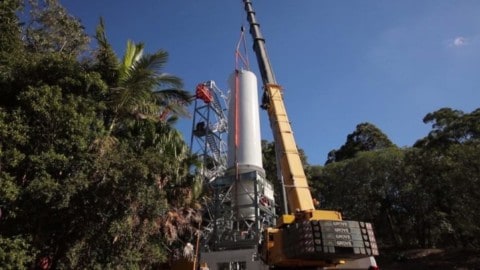The Federal and New South Wales Governments are partnering as part of the Federal Government’s Capacity Investment Scheme, announcing the successful bid of six major dispatchable energy projects across the state.
The projects from this tender alone are equal to 8 per cent of the total 2022/23 New South Wales summer peak demand into the network at short notice – with their combined capacity of 1,075MW.
The projects represent $1.8 billion in energy infrastructure and are expected to create 400 jobs.
The 1,075MW announced exceeds the indicative 930 MW targeted by the tender, which is a partnership between the Capacity Investment Scheme and New South Wales’s Electricity Infrastructure Roadmap.
The successful projects aim to not only help deliver reliability and affordability themselves, but to help drive more investment in cleaner, cheaper energy across the grid.
The six successful projects are:
- Akaysha Energy’s Orana Renewable Energy Zone battery, located in Wellington in central-west New South Wales, with 415MW capacity and 1,660MWh four-hour storage capacity
- AGL Energy’s Liddell battery, located in Muswellbrook, with 500MW capacity and 1,000MWh two-hour storage capacity
- Iberdrola Australia’s Smithfield Sydney battery, located in Smithfield in Western Sydney, with 65MW capacity and 130MWh two-hour storage capacity
- Three separate virtual power plants through Enel X Australia’s demand response project totalling 95MW capacity with minimum dispatch duration of two hours.
All successful projects are targeting commercial operations by December 2025.
Federal Minister for Climate Change and Energy, Chris Bowen, said that firming infrastructure is the key to enabling the rollout of more renewable generation, the cheapest, cleanest form of energy available.
“4GW of dispatchable power left the grid over the past decade with only 1GW to replace it,” Mr Bowen said.
“Announcements like today’s are the result of the Governments getting on with the job of delivering a cleaner, cheaper grid for New South Wales.”
New South Wales Minister for Climate Change and Energy, Penny Sharpe, said that these projects are critical for energy security in the state as it transitions to a cheaper, cleaner energy system.
“We have no time to waste as coal-fired power stations retire. We must get more renewable energy into the grid – backed by storage and flexible demand – to keep the lights on and meet our net zero targets.”
Climate Council response
Climate Council CEO, Amanda McKenzie, said that after a decade of inaction, going all in on renewables is exactly what needs to be done.
“The clean energy switch is already well underway around Australia and building on this momentum will deliver cheaper, more reliable energy as Australia’s ageing and unreliable coal generators give up the ghost,” Ms McKenzie said.
“Ramping up renewables this decade is fundamental to cut pollution from our fossil fuel-powered energy system and electrify transport, industry and more, so that we can end our reliance on expensive coal and gas for good and keep Australians safe from worsening climate change.”
Dr Jennifer Rayner, Head of Advocacy at the Climate Council, said that state governments should now seize the opportunity created by this Federal Government investment to accelerate their own renewable energy plans.
“This investment can unlock the additional energy capacity needed to ensure that coal-fired clunkers like Eraring close on schedule. The New South Wales Government and others right around the country should grab it with both hands,” Dr Rayner said.
“Agreements between the Federal and State Governments under the National Energy Transformation Partnership will be a great way to ensure all governments are pulling in the same direction: adding cheaper, cleaner and more reliable solar and wind energy as quickly as possible.
“As part of this plan the federal government should ensure Australia’s national environment law – the EPBC Act – is updated to say a quick yes to responsible clean energy projects and a decisive no to polluting, climate-wrecking fossil fuel projects.”
Clean Energy Council response
Clean Energy Council Chief Executive, Kane Thornton, said that the Clean Energy Council has been a strong advocate for a major policy response from the Federal Government to accelerate investment in large-scale renewable energy.
“This is why we have welcomed news that the Federal Government has taken decisive action to provide massive support to bring forward new investment in large-scale generation,” Mr Thornton said.
“It is a significant commitment that is intended to put Australia back on track to achieve the Government’s policy of 82 per cent renewables by 2030, replacing ageing coal fired generation with cheaper renewable energy and driving down power prices.
“There is now wide acceptance of the need to accelerate our shift to renewable energy.
“Investment in renewable energy has been in gradual decline since the Renewable Energy Target – a policy that delivered substantial new investment – was met in 2020. The rate of investment slowed more dramatically over the past year as a result of higher project costs, frustrating permitting processes, a congested grid and intensifying global competition in the race to net zero.
“While renewable energy remains the lowest cost form of new generation, there is a clear role for government to facilitate the enormous levels of investment needed to transition our energy system.
Mr Thornton said that the Clean Energy Council looks forward to working closely with the Federal Government on the detailed design of the contracting mechanism to ensure it is effective and delivers the new investment and lower power prices that are expected.
“It’s crucial that any new policy provides increased certainty to investors and the enormous private sector capital and capability that will be essential to Australia becoming a clean energy superpower.
“We also continue to advocate for further support for households and businesses to adopt rooftop solar and household batteries that can reduce power bills and further address cost of living challenges.”
Australian Energy Council response
The Australian Energy Council’s Chief Executive, Sarah McNamara, said that the expanded capacity investment scheme is aimed at helping rally investment in renewables and firming technologies, which has been flagging.
“At 32GW this is a significant injection of new generation capacity into a grid with unresolved system constraints,” Ms McNamara said.
“These include delays in transmission deployment, social licence issues, supply chain bottlenecks and the challenge of maintaining essential system services as more renewables come online.”














